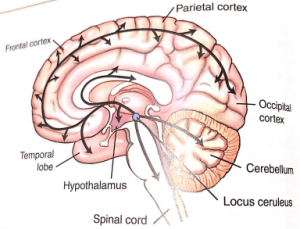Differential diagnosis I
Major Depressive Disorder(MDD)
Rationale:
Major depressive disorder is a mood disorder characterized by the following symptoms: depressed mood, anhedonia, weight changes, sleep changes, fatigue, feelings worthlessness or excessive guilt, poor concentration, and suicidal ideation. This is thought to be a definitive diagnosis when 5 of the previous symptoms are present for at least a two-week period with one of the symptoms being either depressed mood or anhedonia. The patient’s presentation with depressed mood, poor concentration, anhedonia, and difficulty sleeping suggest this disorder as plausible. These factors in association with a family history of mental health problems suggest a rationale for this differential diagnosis.
Differential diagnosis II
Posttraumatic Stress Disorder (PTSD)
Rationale:
A parent’s recent divorce or breaking up with a significant other could both constitute as traumatic experiences which may produce feelings of helplessness associated with PTSD. This disorder also involves emotional detachment from others which may be reflected in the patient’s inability to meet new friends or keep up with current friendships. The combination of these factors provides the rationale for this differential diagnosis. Cortical structures of the limbic system, especially the hippocampus and the amygdala, play a critical role in memory and emotional regulation.
Copyright © 2014, 2010, 2006 by Mosby Inc. an imprint of Elsevier Inc. All rights reserved.
The limbic system plays a key role in emotional regulation and memory consolidation.
Image retrieved from McCance, K. L., & Huether, S. E. (2014). Pathophysiology: The biological basis for disease in adults and children (7thed) (p. 654). St.Louis, MO: Mosby
Differential diagnosis III
Generalized Anxiety Disorder (GAD)
Rationale:
Patient’s presentation of depressed mood, difficulty sleeping, decreased concentration, and family history of mental health/substance abuse issues produce the rationale for this differential diagnosis. Depression, sleep disturbances, and inability to concentrate are symptoms that occur concurrently in both MDD and GAD. These symptoms are often due to variations in the norepinephrine system which originates in the Locus ceruleus and projects to multiple structures in the cortex, cerebellum, and spinal cord.
Copyright © 2019 by Elsevier Inc. All rights reserved.
In the norepinephrine system, signals originate from the Locus ceruleus and relay to various other brain structures.
Image retrieved from McCance, K. L., & Huether, S. E. (2014). Pathophysiology: The biological basis for disease in adults and children (7thed) (p. 650). St.Louis, MO: Mosby

